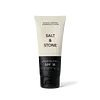What's inside
What's inside
 Key Ingredients
Key Ingredients

 Benefits
Benefits

 Concerns
Concerns

 Ingredients Side-by-side
Ingredients Side-by-side

Zinc Oxide 19.6%
Cosmetic ColorantWater
Skin ConditioningCocos Nucifera Oil
MaskingButyloctyl Salicylate
Skin ConditioningDiheptyl Succinate
EmollientMethyl Dihydroabietate
Butyrospermum Parkii Butter
Skin ConditioningCapryloyl Glycerin/Sebacic Acid Copolymer
Skin ConditioningLavandula Angustifolia Oil
MaskingTheobroma Cacao Seed Butter
EmollientSodium Hyaluronate
HumectantHelianthus Annuus Seed Oil
EmollientSalvia Officinalis Oil
MaskingGlycerin
HumectantCaprylhydroxamic Acid
Camellia Sinensis Leaf Extract
AntimicrobialCalendula Officinalis Flower Extract
MaskingWithania Somnifera Root Extract
Skin ConditioningTocopherol
AntioxidantBisabolol
MaskingCetyl Alcohol
EmollientSodium Gluconate
Skin ConditioningCitric Acid
BufferingMicrocrystalline Cellulose
AbsorbentCellulose Gum
Emulsion StabilisingCaprylyl Glycol
EmollientCetearyl Alcohol
EmollientCoco-Glucoside
CleansingSodium Stearoyl Glutamate
CleansingArachidyl Alcohol
EmollientArachidyl Glucoside
EmulsifyingBehenyl Alcohol
EmollientPolyhydroxystearic Acid
EmulsifyingZinc Oxide 19.6%, Water, Cocos Nucifera Oil, Butyloctyl Salicylate, Diheptyl Succinate, Methyl Dihydroabietate, Butyrospermum Parkii Butter, Capryloyl Glycerin/Sebacic Acid Copolymer, Lavandula Angustifolia Oil, Theobroma Cacao Seed Butter, Sodium Hyaluronate, Helianthus Annuus Seed Oil, Salvia Officinalis Oil, Glycerin, Caprylhydroxamic Acid, Camellia Sinensis Leaf Extract, Calendula Officinalis Flower Extract, Withania Somnifera Root Extract, Tocopherol, Bisabolol, Cetyl Alcohol, Sodium Gluconate, Citric Acid, Microcrystalline Cellulose, Cellulose Gum, Caprylyl Glycol, Cetearyl Alcohol, Coco-Glucoside, Sodium Stearoyl Glutamate, Arachidyl Alcohol, Arachidyl Glucoside, Behenyl Alcohol, Polyhydroxystearic Acid
Water
Skin ConditioningGlycerin
HumectantIsopropyl Palmitate
EmollientCetearyl Alcohol
EmollientCeteareth-20
CleansingPanthenol
Skin ConditioningNiacinamide
SmoothingTocopheryl Acetate
AntioxidantDimethicone
EmollientPersea Gratissima Oil
Skin ConditioningHelianthus Annuus Seed Oil
EmollientPantolactone
HumectantGlyceryl Stearate
EmollientSodium Benzoate
MaskingBenzyl Alcohol
PerfumingCitric Acid
Buffering
 Reviews
Reviews

Ingredients Explained
These ingredients are found in both products.
Ingredients higher up in an ingredient list are typically present in a larger amount.
Cetearyl alcohol is a mixture of two fatty alcohols: cetyl alcohol and stearyl alcohol. It is mainly used as an emulsifier. Emulsifiers help prevent the separation of oils and products. Due to its composition, it can also be used to thicken a product or help create foam.
Cetearyl alcohol is an emollient. Emollients help soothe and hydrate the skin by trapping moisture.
Studies show Cetearyl alcohol is non-toxic and non-irritating. The FDA allows products labeled "alcohol-free" to have fatty alcohols.
This ingredient is usually derived from plant oils such as palm, vegetable, or coconut oils. There is debate on whether this ingredient will cause acne.
Due to the fatty acid base, this ingredient may not be Malassezia folliculitis safe.
Learn more about Cetearyl AlcoholCitric Acid is an alpha hydroxy acid (AHA) naturally found in citrus fruits like oranges, lemons, and limes.
Like other AHAs, citric acid can exfoliate skin by breaking down the bonds that hold dead skin cells together. This helps reveal smoother and brighter skin underneath.
However, this exfoliating effect only happens at high concentrations (20%) which can be hard to find in cosmetic products.
Due to this, citric acid is usually included in small amounts as a pH adjuster. This helps keep products slightly more acidic and compatible with skin's natural pH.
In skincare formulas, citric acid can:
While it can provide some skin benefits, research shows lactic acid and glycolic acid are generally more effective and less irritating exfoliants.
Most citric acid used in skincare today is made by fermenting sugars (usually from molasses). This synthetic version is identical to the natural citrus form but easier to stabilize and use in formulations.
Read more about some other popular AHA's here:
Learn more about Citric AcidGlycerin is already naturally found in your skin. It helps moisturize and protect your skin.
A study from 2016 found glycerin to be more effective as a humectant than AHAs and hyaluronic acid.
As a humectant, it helps the skin stay hydrated by pulling moisture to your skin. The low molecular weight of glycerin allows it to pull moisture into the deeper layers of your skin.
Hydrated skin improves your skin barrier; Your skin barrier helps protect against irritants and bacteria.
Glycerin has also been found to have antimicrobial and antiviral properties. Due to these properties, glycerin is often used in wound and burn treatments.
In cosmetics, glycerin is usually derived from plants such as soybean or palm. However, it can also be sourced from animals, such as tallow or animal fat.
This ingredient is organic, colorless, odorless, and non-toxic.
Glycerin is the name for this ingredient in American English. British English uses Glycerol/Glycerine.
Learn more about GlycerinHelianthus Annuus Seed Oil is the oil derived from the seeds of a Sunflower. Sunflower seed oil is non-fragrant. It is an emollient, meaning it helps to soften the skin.
Sunflower seed oil contains many fatty acids. The fatty acids found in sunflower seeds include (from highest amount to least): linoleic acid, myristic acid, palmitic acid, stearic acid, arachidic acid, oleic acid, and linolenic acid.
These fatty acids help the skin create ceramides. Ceramides play a role in repairing the skin barrier.
Helianthus Annuus Seed Oil helps moisturize the skin. This in turn helps the skin look more rejuvenated and smoother.
Sunflowers are rich in vitamin E.
Historians believe Indigenous cultures of North America domesticated sunflowers before corn. Thus they relied on sunflower oil for a variety of uses. One such use is moisturizing skin and hair.
Sunflower seed oil may not be fungal acne safe. We recommend speaking with a professional if you have any concerns.
Learn more about Helianthus Annuus Seed OilWater. It's the most common cosmetic ingredient of all. You'll usually see it at the top of ingredient lists, meaning that it makes up the largest part of the product.
So why is it so popular? Water most often acts as a solvent - this means that it helps dissolve other ingredients into the formulation.
You'll also recognize water as that liquid we all need to stay alive. If you see this, drink a glass of water. Stay hydrated!
Learn more about Water